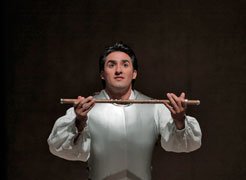
All photos: Ken Howard
Santa Fe, New Mexico
July 14, 2010
The Magic Flute's current production at the Santa Fe Opera is as streamlined as a Twitter posting. Director Tim Albery's fast-paced action, with his own updated and pared down English dialogue, does not ruminate on the philosophical implications of Mozart's Masonic symbolism. Its lightness of being chases away the shadows.
Tobias Hoheisel's sleek set pieces establish the tone. Two flanges on either side of the stage gracefully narrow to a backdrop open to Santa Fe's distant mountains.
Minimalist décors merely suggest scenes; Papageno's bird-gathering forays into the forest, for instance, encounter only thin poles, each with a single bird on top, all of them soon bagged.
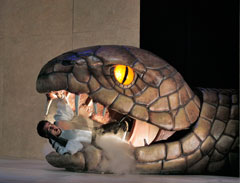
Don't count on delays from scary animals. Tamino's nemesis serpent has but a momentary, ineffectual grip; its chomping teeth are all show. Other normally dangerous forest predators appear with Tamino almost as benign deities.
The noble and wise Sarastro, customarily a bit standoffish, here exudes avuncular warmth as he sits in the garden chatting up Pamina. Initiation rites into his temple of brotherhood will prove an expedited process.
Tamino's journey of silence has him merely looking the other way as Papageno indulges in a fast food lunch and drinks from a soda can. Likewise, Tamino and Pamina's trials by fire and water are quickly dispensed with; the two briefly stop at one wall floodlit in designer Jennifer Tipton's copper-tones followed by the other in her turquoise. These novitiates get awarded just for showing up, as if they were attending one of those feel-good schools that emphasizes self-esteem over achievement.
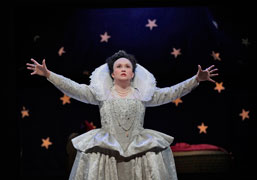 In standard productions, the venomous Queen of the Night casts out metaphoric shards of broken-glass in her revenge aria. But this Queen chirps as sweetly as one of Papageno's caged birds. By the end, she even seems reconciled to her daughter's switched allegiance to Sarastro and his realm. Threatening Monostatos, garbed in a fascistic trench coat and dark glasses, need only have his spectacles removed by Sarastro to immediately see the enlightenment of day.
In standard productions, the venomous Queen of the Night casts out metaphoric shards of broken-glass in her revenge aria. But this Queen chirps as sweetly as one of Papageno's caged birds. By the end, she even seems reconciled to her daughter's switched allegiance to Sarastro and his realm. Threatening Monostatos, garbed in a fascistic trench coat and dark glasses, need only have his spectacles removed by Sarastro to immediately see the enlightenment of day.
All this shaving off of rough edges clearly cuts what little dramatic tension inherently exists in the work, but the conflict resolution of librettist Emanuel Schikaneder's loveable protagonists has never been in doubt anyway.
The most intriguing aspect of the production is Hoheisel's costume designs. They deftly juxtapose several anachronistic fashions of vaguely English origin, symbolically peeling away antiquity in favor of an emerging modern era.
The Queen of the Night wears the brittle glitter of the Elizabethan court at the launch of the Age of Reason. Sarastro and his cohorts wear the Puritanical garb of the later Cromwell era of monarchial reform.
Tamino appears at first to be a lost Spanish nobleman, but he and Pamina soon change into simple clothes that suggest a modernizing 19th Century. Papageno and Papagena skip even further forward to inhabit 20th Century sportswear, having long buried the struggles of political and religious ideology stemming from the Queen of Night and Sarastro.
Mozart's enchanted Singspiel bubbles over with goodwill and catchy tunes, captured glowingly by a fine cast of appropriately young singers. Conductor Lawrence Renes partners them with clear orchestral textures and a breezy pacing that lends the production an untroubled suavity.
As Tamino, Charles Castronovo's lyric tenor is elegant, pliant, and well-projected throughout Santa Fe's Crosby Theatre. His dramatic performance delivers the sincerity and high purpose inherent in Tamino's noble character and emblematic of the opera's more serious undercurrents.
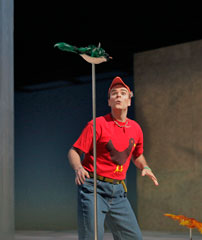 Baritone Joshua Hopkins' return engagement to Santa Fe as Papageno is equally affecting, a good vocal complement to Castronovo. As the earthy commoner, he conveys a go-along, get-along bonhomie that is little concerned with the why of things. Though he pines for a girl and seems not up to some of his trials, he can rise to commanding action when a lady is threatened. In short, he's much like most of us.
Baritone Joshua Hopkins' return engagement to Santa Fe as Papageno is equally affecting, a good vocal complement to Castronovo. As the earthy commoner, he conveys a go-along, get-along bonhomie that is little concerned with the why of things. Though he pines for a girl and seems not up to some of his trials, he can rise to commanding action when a lady is threatened. In short, he's much like most of us.
Erin Morley's coloratura soprano lends unerring vocal virtuosity to her Queen of the Night. Her appearance is dazzling, all in glittering white, but her vocal venom in the revenge aria feels a bit subdued and too carefully produced. She is the least threatening but certainly the most likable nocturnal sovereign in recent memory.
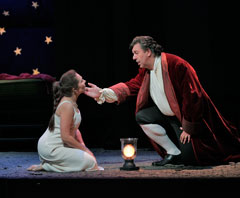 Andrea Silvestrelli's basso was embracing and reassuring as Sarastro, even as it thinned a tad in the more profundo regions. This is a particularly warm and human characterization, his dialogue made more charming by an Italian-inflected English.
Andrea Silvestrelli's basso was embracing and reassuring as Sarastro, even as it thinned a tad in the more profundo regions. This is a particularly warm and human characterization, his dialogue made more charming by an Italian-inflected English.
Russian soprano Ekaterina Siurina makes her SFO debut as the sweetly poised, and also independent-minded, Pamina. Her future best friend, the Papagena of soprano Jamie-Rose Guarrine, shows promise in the SFO's apprentice program.
Timothy Oliver's tenor was pointed and threatening as the leering Monostatos under dark glasses - those glasses the only hint at the character's original conceptualization.
As the Three Ladies, Rachel Willis-Sørensen, Audrey Walstrom, and Renée Tatum were charming as the helpful and amorous interveners in Tamino's encounter with the serpent.
The oddest conceived characters were the Three Spirits of Sean Jahner, Trent Llewellyn and Craig Short - all of them tall and thin boys dressed in orange saris and resembling emaciated Krishna deities. (The Dalai Lama may be cultivating some apprentices.)
With its continuous flow of chirping birds, busy bells, and general goodwill, this Magic Flute gives us one of the swifter victories of Enlightenment values over the powers of darkness.
Oh that such triumphs could as easily be achieved in real life.
Magic Flute runs through August 27. Contact the Santa Fe Opera
Rodney Punt is at Rodney@artspacifica.net